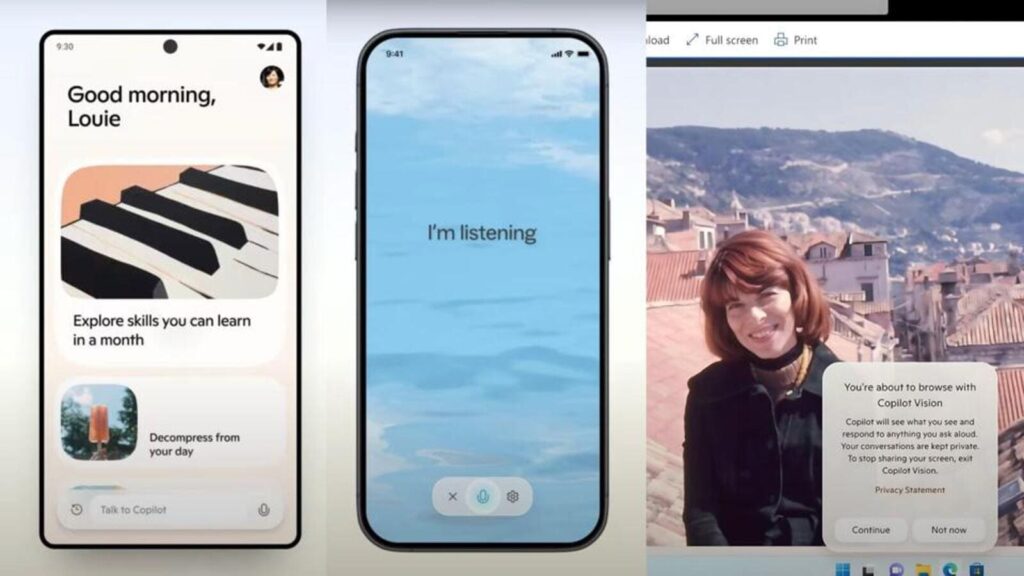‘Can adapt to your habits, still very much a digital entity’: Microsoft Copilot

It is imperative to start with this observation — your chats with Copilot may not sync across devices. And the voice mode may not be immediately available That’s our experience from a conversation with the new Copilot via the app for iPhone. We discussed its updates, and that lead to a conversation about the meaning of life. That chat isn’t available on the desktop (some older conversations are, mind you). Nevertheless, Microsoft has rolled out a significant update for its Copilot artificial intelligence (AI) assistant.

The highlights include a complete redesign of the web & app interfaces, OpenAI’s GPT-4o and o1 models likely on board, an ability to hold conversation, a new voice mode (in the same landscape is ChatGPT’s Advanced Voice mode) and it’ll read out a curated news package. That’s the broader view, the exciting and definitive changes lie deeper.
Also Read:Tech Tonic | The legacy of Mira Murati, and more chapters remain to be written
Who better to ask about Copilot’s latest set of upgrades, than Copilot itself? That’s what we did. “I aim to act as a helpful, intuitive companion. I can understand your needs, adapt to your habits, and provide more human-like interactions—but I’m still very much a digital entity with my own unique advantages. Not a human, but designed to make your life easier and more interesting,” is how Copilot describes itself.
“In the field of AI, we often get caught up in the technical details. We spend our time talking about parameters and compute. The focus is on training runs, data centers and the latest techniques. But I think it’s important that in doing all of this, getting stuck right in the technical weeds, we don’t lose sight of not only what we are building, but why we are building it,” Mustafa Suleyman, executive vice-president and CEO of Microsoft AI, said in a statement.
Also Read:We’re focused on designing products for people, that solve problems: Jake Dyson
As you interact more with Copilot, you’ll begin to realise that it can now do step-by-step answers for complex questions that may require a bit more handholding. The search results are supposedly more “enhanced”, though mileage on that may vary depending on your query and the search results it can tap up from its compatriot, Bing. Copilot also claims to do better image generation with text prompts, than before, but in the early hours post this update, we faced multiple errors in that pursuit.
Personal adaptation is something that will likely show its true form a few weeks, as it understands your conversations as well as how you’re using Microsoft’s apps and services across devices. Speaking of apps, Copilot finds deeper integration within the Edge web browser — this should be useful to summarise webpage content, get queries answered, search within web pages or translate.
Also Read:Tech Tonic | Shouldn’t tech regulation be a proportionate, two-way street?
“Over time it’ll adapt to your mannerisms and develop capabilities built around your preferences and needs. We are not creating a static tool so much as establishing a dynamic, emergent and evolving interaction,” Suleyman said. A lot of what Microsoft is promising with Copilot, will become visible in the days and weeks ahead, because personalisation will take time. “This is the beginning of a fundamental shift in what’s possible for all of us. It’s a long journey that will take years. With our latest updates to Copilot, you are seeing only the first careful steps in this direction,” he adds, referencing the need to let time chart that course.
Copilot Vision is supposed to be Copilot’s eyes and ears, which is being able to see and talk about it in realtime. “It understands the web page you’re viewing, both text and images, and can answer questions about its content, suggest next steps and help you without disrupting your workflow. Imagine you’re trying to furnish a new apartment, Copilot Vision can help you search for furniture, find the right colour palette, think through your options on everything from rugs to throws and even suggest ways of arranging what you’re looking at,” is how Microsoft describes it.
Also Read:Data centres: Balancing AI needs with sustainability
Unfortunately, day one bugs seem to be figuring prominently in our interactions with the updated Copilot assistant. In addition to voice mode bugs and errors in generating images from text prompts, Vision also seemed to be facing issues. “It seems I had a little glitch and the tool isn’t accessible right now. But don’t let that get you down!” An apologetic Copilot, describing the situation.
A lot of this functionality is referenced within phased rollouts, which could be the reason for encountering these glitches in the absence of any region-wise functionality limitations and descriptors for users.
Copilot Voice is first rolling out for English in Australia, Canada, New Zealand, the United Kingdom and the United States. Microsoft says this will expand to more regions and languages soon. Copilot Daily, the news capsule, is now available in the US and UK, with more countries expected to join that small list soon (no surprise, we could see Copilot Daily in our app in India, but it never played back). Copilot Vision is rolling out to Copilot Labs soon, and will be available some Copilot Pro subscribers in the United States, at the start of that journey.
Personalization in Copilot is available globally, working behind the scenes, with an option for users to opt-out in the Copilot app settings. “We’re still finalizing options for offering personalization to users in the European Economic Area and the United Kingdom,” confirms Microsoft, in a move that’s absolutely not surprising considering the region’s often confusing and conflicting guidelines. Apple is refraining from releasing Apple Intelligence in the EU, while Meta has also held back its latest Llama models.




